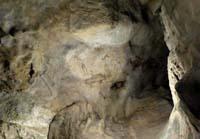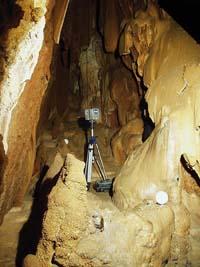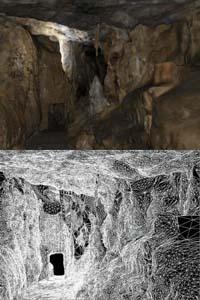Inside the chapel, in the eyes of Santimamiñe

It has been almost a century since they discovered the famous paintings of Santimamiñe (1916). Since then there have been few visitors who have visited these paintings and the cave itself. This has caused numerous damage to the cave.
The vulnerability of Santimamiñe's heritage is not a new concern. Studies conducted in the last two decades of the last century have already demonstrated the need to reduce visits and in 1997 the painting chamber was closed and a limit of 75 daily visitors was established.
But that was not enough. Visitor infrastructures, mainly light and metal structures, generate a growth of colonies of microorganisms and plants, transforming the parameters of the environment (temperature, oxidation, condensation, etc. ). In addition, visitors increase the amount of CO 2, raising dust from the ground and probably spores.
All these problems led to the fact that in 2006 it was considered necessary to turn off the lights of the cave and that it remained closed to ensure its conservation. This posed a problem, since they wanted to continue socializing the wealth of heritage, but without endangering their own heritage.
This is the problem that many organizations and administrations across Europe have. The exploitation of tourist resources has in many cases caused its deterioration. And they are trying to solve this problem in various ways. In the case of the caves, the only solution so far has been the realization of precise physical replicas of the originals. But this solution has several drawbacks: they are very expensive, require a certain physical space, require maintenance, have no mobility, etc.
The Basque company Virtualware, dedicated to the development of virtual reality technologies, has proposed a new solution for Santimamiñe: virtual visits. This, in addition to solving the problems that physical models have, adds innovation and visibility, the tourist hooks.

Cave inside the hermitage
Now visitors will visit the cave atrium first, but they will not advance in it. And everything else will remain in the dark and only progress can be made for research and care. However, visitors will have the opportunity to see the entire cave and also the paintings. To do this, they must leave the cave and enter the hermitage of San Mamés, located next to it. And there yes, there you can go through the cave, even virtually.
To do this, they have installed a complete equipment of audiovisual devices and a stereoscopic screen of 3.5 m wide by 2.5 m high. Visitors will wear glasses and tour the virtual cave exactly the same as the original. A guide will guide visitors through rooms and show them all the elements of interest of each place. According to virtualware, the spectacularity of visualization, the interactivity of the entire journey and the surround sound generate a striking sensation.
The development of the virtual representation of the cave has been key in this innovative solution. This representation presents a great complexity against other possibilities of integration of heritage today. Virtualware has digitized and modeled the entire cave and faced a technological challenge: balancing the huge amount of initial data and the current limitations of real-time processing.
Realistic representation
Virtualware has reflected with great detail and precision the 450 m --10 interconnected rooms - of the true cave, with a mistake of 5 cm throughout its journey. To do this, the first step has been to take field data. Among other things, through a very high precision 3D laser scanner, the entire cave has been scanned and 1,500 high-definition digital photographs have been taken. Thus, 6,000 million points of information about the cave were obtained. In addition, geomorphological maps provided by a geological office, the inventory of the cave (belonging to the Provincial Council of Bizkaia), calcos of all cave paintings, environmental sounds collected in situ, videos, etc. have been used.

Analyzing and processing all the information collected, a three-dimensional model of the entire space has been constructed: a polygonal model of millions of triangles. And on this model they have formed a virtual cave, with colors, shadows, photorealistic textures and lighting, integrating all the elements of Santimamiñe.
Finally, with this representation they have created an application that allows to move inside the cave. This application allows you to circulate throughout the cave and obtain multimedia information from each point in an interactive way.
It is undoubtedly a new way to visit a cave. The latest technologies go back in time to discover works of art and residence of ancient ancestors. I haven't been there yet, but when I'm gone I think to scream as soon as I put on my glasses: Is there someone at home?





